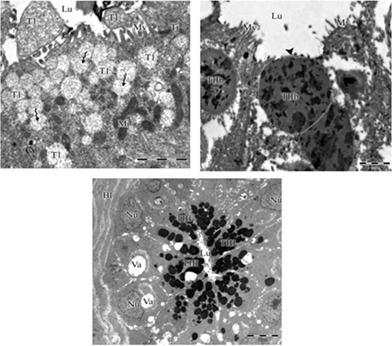当前位置:
X-MOL 学术
›
J. Morphol.
›
论文详情
Our official English website, www.x-mol.net, welcomes your feedback! (Note: you will need to create a separate account there.)
Sexual segment of the kidney of the lizard, Eutropis carinata : A light microscopic and ultrastructural seasonal study
Journal of Morphology ( IF 1.5 ) Pub Date : 2020-12-15 , DOI: 10.1002/jmor.21302 Shanthakumar Samson 1 , Mahadevaiah Bhagya 1 , Chandrasekhar Sagar Bhadravathi 2 , Ivan Aranha 3
Journal of Morphology ( IF 1.5 ) Pub Date : 2020-12-15 , DOI: 10.1002/jmor.21302 Shanthakumar Samson 1 , Mahadevaiah Bhagya 1 , Chandrasekhar Sagar Bhadravathi 2 , Ivan Aranha 3
Affiliation

|
We studied seasonal variation of the secretory granules in the epithelial cells of the sexual segment of the kidney (SSK) during the annual sexual cycle in the lizard, Eutropis carinata using light and electron microscopy in correlation with measurements of androgen levels. During the breeding phase, the epithelium of the SSK consists of simple columnar cells with basal nuclei. The cytoplasm contains numerous eosinophilic secretory protein and carbohydrate granules, but lacks glycosaminoglycans. These secretory granules develop during the regenerative phase when the circulating testosterone level increase. During the breeding phase, when the circulating testosterone levels are high, three types of secretory granules can be differentiated in the cytoplasm based on size and opacity; electron translucent type I, electron dense type II, and biphasic type III granules. Type II granules are found at various stages of maturity and degeneration/utilization. All types of secretory granules are released through an apocrine process. Microvilli and tight junctions are prominent at the apical portion of the cell. The cytoplasm contains, Golgi complexes, an abundant network of rough endoplasmic reticulum, numerous tubular mitochondria, condensing, mucus filled and empty vacuoles. Intercellular canaliculi are narrow and indistinct during the regenerative and breeding phases, respectively. During the regressed phase, when the circulating testosterone levels are lowest, the cells are found regressed with wide intercellular canaliculi and devoid of secretory granules. Then the cytoplasm contains a few round mitochondria, Golgi and scanty endoplasmic reticulum.
中文翻译:

蜥蜴肾脏的性节,Eutropis carinata:光显微和超微结构季节性研究
我们使用与雄激素水平测量相关的光学和电子显微镜研究了在蜥蜴 Eutropis carinata 的年度性周期中肾脏性节 (SSK) 上皮细胞中分泌颗粒的季节性变化。在繁殖阶段,SSK 的上皮由具有基底核的简单柱状细胞组成。细胞质含有大量嗜酸性分泌蛋白和碳水化合物颗粒,但缺乏糖胺聚糖。当循环睾酮水平增加时,这些分泌颗粒在再生阶段形成。在繁殖期,当循环睾酮水平高时,可根据大小和不透明度将细胞质中的三种分泌颗粒区分开来;电子半透明型 I,电子致密型 II,和双相 III 型颗粒。II 型颗粒存在于成熟和退化/利用的各个阶段。所有类型的分泌颗粒都是通过顶泌过程释放的。微绒毛和紧密连接在细胞的顶端部分很突出。细胞质包含高尔基复合体、丰富的粗面内质网网络、无数管状线粒体、凝聚、充满粘液的空泡。在再生和繁殖阶段,细胞间小管分别狭窄和模糊。在退化阶段,当循环睾酮水平最低时,发现细胞退化,细胞间小管较宽,没有分泌颗粒。然后细胞质含有数个圆形线粒体、高尔基体和稀少的内质网。II 型颗粒存在于成熟和退化/利用的各个阶段。所有类型的分泌颗粒都是通过顶泌过程释放的。微绒毛和紧密连接在细胞的顶端部分很突出。细胞质包含高尔基复合体、丰富的粗面内质网网络、无数管状线粒体、凝聚、充满粘液的空泡。在再生和繁殖阶段,细胞间小管分别狭窄和模糊。在退化阶段,当循环睾酮水平最低时,发现细胞退化,细胞间小管较宽,没有分泌颗粒。然后细胞质含有数个圆形线粒体、高尔基体和稀少的内质网。II 型颗粒存在于成熟和退化/利用的各个阶段。所有类型的分泌颗粒都是通过顶泌过程释放的。微绒毛和紧密连接在细胞的顶端部分很突出。细胞质包含高尔基复合体、丰富的粗面内质网网络、无数管状线粒体、凝聚、充满粘液的空泡。在再生和繁殖阶段,细胞间小管分别狭窄和模糊。在退化阶段,当循环睾酮水平最低时,发现细胞退化,细胞间小管较宽,没有分泌颗粒。然后细胞质含有数个圆形线粒体、高尔基体和稀少的内质网。
更新日期:2020-12-15
中文翻译:

蜥蜴肾脏的性节,Eutropis carinata:光显微和超微结构季节性研究
我们使用与雄激素水平测量相关的光学和电子显微镜研究了在蜥蜴 Eutropis carinata 的年度性周期中肾脏性节 (SSK) 上皮细胞中分泌颗粒的季节性变化。在繁殖阶段,SSK 的上皮由具有基底核的简单柱状细胞组成。细胞质含有大量嗜酸性分泌蛋白和碳水化合物颗粒,但缺乏糖胺聚糖。当循环睾酮水平增加时,这些分泌颗粒在再生阶段形成。在繁殖期,当循环睾酮水平高时,可根据大小和不透明度将细胞质中的三种分泌颗粒区分开来;电子半透明型 I,电子致密型 II,和双相 III 型颗粒。II 型颗粒存在于成熟和退化/利用的各个阶段。所有类型的分泌颗粒都是通过顶泌过程释放的。微绒毛和紧密连接在细胞的顶端部分很突出。细胞质包含高尔基复合体、丰富的粗面内质网网络、无数管状线粒体、凝聚、充满粘液的空泡。在再生和繁殖阶段,细胞间小管分别狭窄和模糊。在退化阶段,当循环睾酮水平最低时,发现细胞退化,细胞间小管较宽,没有分泌颗粒。然后细胞质含有数个圆形线粒体、高尔基体和稀少的内质网。II 型颗粒存在于成熟和退化/利用的各个阶段。所有类型的分泌颗粒都是通过顶泌过程释放的。微绒毛和紧密连接在细胞的顶端部分很突出。细胞质包含高尔基复合体、丰富的粗面内质网网络、无数管状线粒体、凝聚、充满粘液的空泡。在再生和繁殖阶段,细胞间小管分别狭窄和模糊。在退化阶段,当循环睾酮水平最低时,发现细胞退化,细胞间小管较宽,没有分泌颗粒。然后细胞质含有数个圆形线粒体、高尔基体和稀少的内质网。II 型颗粒存在于成熟和退化/利用的各个阶段。所有类型的分泌颗粒都是通过顶泌过程释放的。微绒毛和紧密连接在细胞的顶端部分很突出。细胞质包含高尔基复合体、丰富的粗面内质网网络、无数管状线粒体、凝聚、充满粘液的空泡。在再生和繁殖阶段,细胞间小管分别狭窄和模糊。在退化阶段,当循环睾酮水平最低时,发现细胞退化,细胞间小管较宽,没有分泌颗粒。然后细胞质含有数个圆形线粒体、高尔基体和稀少的内质网。



























 京公网安备 11010802027423号
京公网安备 11010802027423号